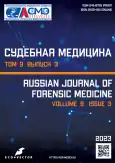Morphological study of fly-ash block under angular impact of 9 mm projectile
- Authors: Singh M.1, Rohatgi D.1, Kumar S.2, Gupta D.3
-
Affiliations:
- LNJN NICFS National Forensic Sciences University
- National Forensic Sciences University – Ballistics Research Centre & Testing Range
- Department of Forensic Medicine & Toxicology, All India Institute of Medical Sciences
- Issue: Vol 9, No 3 (2023)
- Pages: 255-266
- Section: Original study articles
- URL: https://journals.rcsi.science/2411-8729/article/view/148347
- DOI: https://doi.org/10.17816/fm7512
- ID: 148347
Cite item
Abstract
BACKGROUND: Concrete structures utilized in protective buildings such as ammunition depots and bunkers are susceptible to missile impacts, necessitating a comprehensive ballistic assessment involving penetration and perforation mechanics. Most of the empirical and analytical models for projectile penetration in concrete primarily focus on determining the penetration depth, scabbing, and perforation thicknesses. Concrete structures subjected to firearm attacks exhibit distinct fracture modes that can aid in identifying the firearm used and potential firing locations.
AIM: This study aims to comprehend the effects of the angular firing of a 9 mm full metal jacketed projectile on aerated concrete blocks, fired from a 5 m range. The goal is to generate hypotheses and conclusions based solely on the observable damage resulting from bullet impacts. A meticulous analysis of the incurred damages can unveil a range of possibilities.
MATERIALS AND METHODS: The sample comprised 12 aerated concrete blocks, each subject to 9×19 mm bullets fired from four different angles: 0°, 15°, 30°, and 45°. The relationship between impact angle and entry hole dimensions was established using the best-fit ellipse method.
RESULTS: Examination of the fracture pattern revealed significant damage at both entry and exit holes for a 0° impact angle. As the impact angle increased, the exit hole diameter progressively decreased, culminating in no perforation at a 45° angle. This trend correlated with fracture patterns near entry and exit holes, along with energy dissipation at the impact site corresponding to the impact angle.
CONCLUSION: A trend was observed between projectile energy loss upon impact and resultant damage to aerated concrete block surfaces. Analysis of aerated concrete block components deposited on the bullets, including rifling details, can help link them to the gunshot openings and firearms recovered at crime scenes.
Keywords
Full Text
##article.viewOnOriginalSite##About the authors
Malika Singh
LNJN NICFS National Forensic Sciences University
Email: singhmalika98@gmail.com
ORCID iD: 0009-0005-4749-1622
India, New Delhi
Dr. Richa Rohatgi
LNJN NICFS National Forensic Sciences University
Email: rrohatgi2020@gmail.com
ORCID iD: 0000-0001-5514-953X
MD, Dr. Sci. (Med.), Assistant Professor
India, New DelhiSaurabh Kumar
National Forensic Sciences University – Ballistics Research Centre & Testing Range
Author for correspondence.
Email: saurabh.kumar@nfsu.ac.in
ORCID iD: 0000-0001-8442-1096
MD, Dr. Sci. (Med.)
India, GandhinagarDr Sanjay Gupta
Department of Forensic Medicine & Toxicology, All India Institute of Medical Sciences
Email: drsanjaymdfm@gmail.com
ORCID iD: 0000-0003-3829-3155
MD, Dr. Sci. (Med.), Professor
India, Rajkot (Gujarat)References
- Heard B. Handbook of firearms and ballistics, 2nd ed. Hoboken, N.J.: Wiley; 2013.
- Jamnam S, Maho B, Techaphatthanakon A, et al. Steel fiber reinforced concrete panels subjected to impact projectiles with different caliber sizes and muzzle energies. Case Studies Construction Materials. 2020;(13):e0030. doi: 10.1016/j.cscm.2020.e00360
- Backman M. Terminal ballistics. China Lake, Calif: Naval Weapons Center; 1976. 232 р.
- Werner S, Thienel K, Kustermann A. Study of fractured surfaces of concrete caused by projectile impact. Int J Impact Engineering. 2013;(52):23–27. doi: 10.1016/j.ijimpeng.2012.09.005
- Mattijssen E, Kerkhoff W. Bullet trajectory reconstruction: Methods, accuracy and precision. Forensic Sci Int. 2016;(262):204–211. doi: 10.1016/j.forsciint.2016.03.039
- Bureau of Indian Standards: E-Sale Search Result. Standardsbis.bsbedge.com; 1984. [Online]. Available from: https://standardsbis.bsbedge.com/BIS_SearchStandard.aspx?keyword=autoclaved%20&id=0. Accessed: 11 Feb 2022.
- AAC Block. Satyambuildtech.com. [Online]. Available from: https://www.satyambuildtech.com. Accessed: 28 Apr 2022.
- Visit of Bimstecnations Army Chiefs, Ficci.in, 2018. [Online]. Available from: https://ficci.in/events/23972/ISP/FICCI_ADB_Defence_EquipmentCatalogue_For_BIMSTEC_Nations.pdf. Accessed: 13 May 2022.
- Li Q, Chen X. Penetration and perforation into metallic targets by a non-deformable projectile. Engineering Plasticity Impact Dynamics. 2001. doi: 10.1142/9789812794536_0010
- Liscio E, Imran R. Angle of impact determination from bullet holes in a metal surface. Forensic Sci Int. 2020;(317):110504. doi: 10.1016/j.forsciint.2020.110504
- Walters M, Liscio E. The accuracy and repeatability of reconstructing single bullet impacts using the 2D ellipse method. J Forensic Sci. 2020;65(4):1120–1127. doi: 10.1111/1556-4029.14309
- Nordin F, Bominathan U, Abdullah A, Chang K. Forensic significance of gunshot impact marks on inanimate objects: The need for translational research. J Forensic Sci. 2019;65(1):11–25. doi: 10.1111/1556-4029
- Gangopadhyay S, Rohatgi R. Trajectory simulations by the numerical solution of the point-mass equations of motion for 7.62 mm/.308” rifle bullets. Russ J Forensic Med. 2022;8(2):23–36. (In Russ). doi: 10.17816/fm730
Supplementary files


















